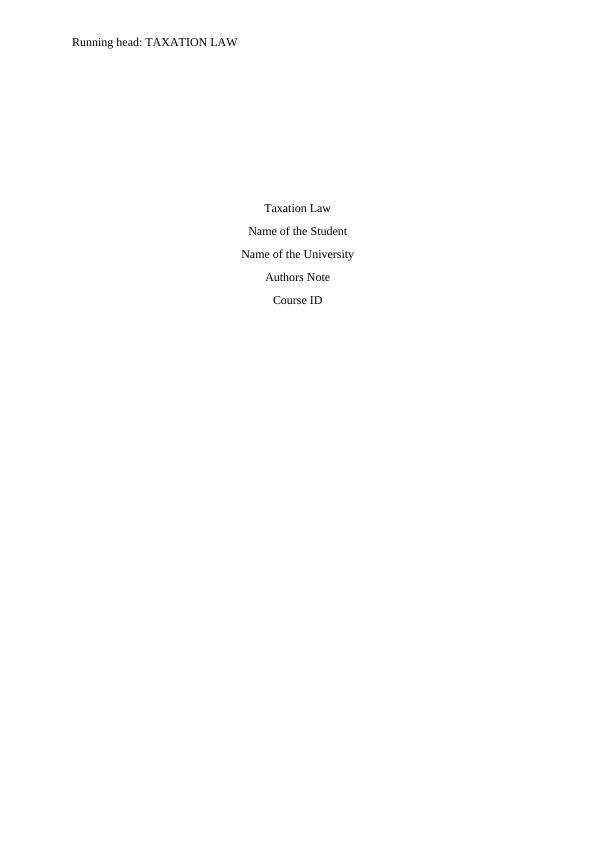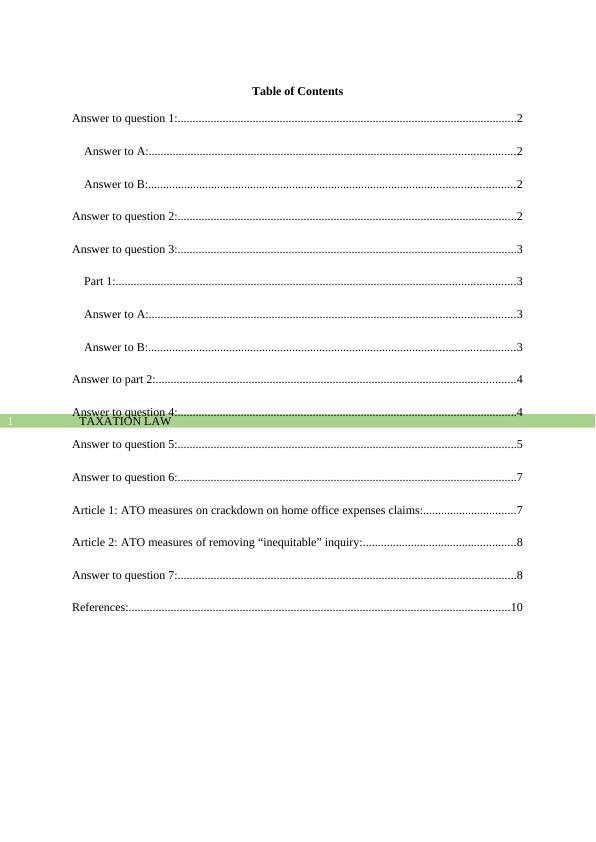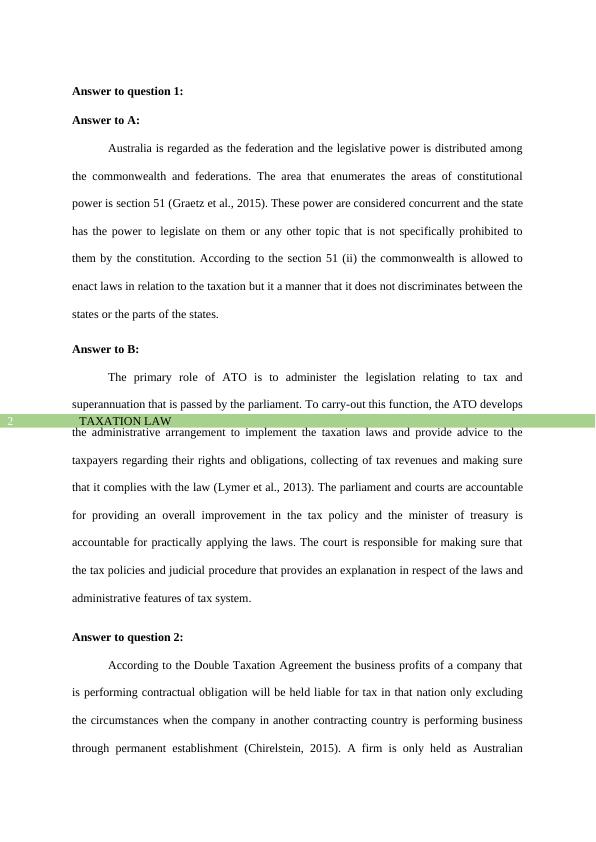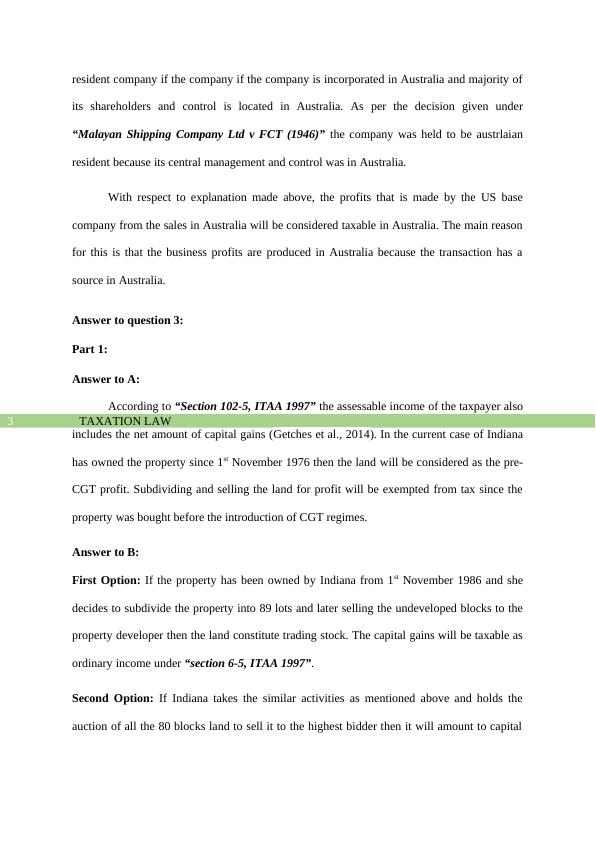Taxation Law
Added on 2022-12-26
12 Pages2884 Words1 Views
Running head: TAXATION LAW
Taxation Law
Name of the Student
Name of the University
Authors Note
Course ID
Taxation Law
Name of the Student
Name of the University
Authors Note
Course ID

TAXATION LAW1
Table of Contents
Answer to question 1:.................................................................................................................2
Answer to A:..........................................................................................................................2
Answer to B:..........................................................................................................................2
Answer to question 2:.................................................................................................................2
Answer to question 3:.................................................................................................................3
Part 1:.....................................................................................................................................3
Answer to A:..........................................................................................................................3
Answer to B:..........................................................................................................................3
Answer to part 2:........................................................................................................................4
Answer to question 4:.................................................................................................................4
Answer to question 5:.................................................................................................................5
Answer to question 6:.................................................................................................................7
Article 1: ATO measures on crackdown on home office expenses claims:...............................7
Article 2: ATO measures of removing “inequitable” inquiry:...................................................8
Answer to question 7:.................................................................................................................8
References:...............................................................................................................................10
Table of Contents
Answer to question 1:.................................................................................................................2
Answer to A:..........................................................................................................................2
Answer to B:..........................................................................................................................2
Answer to question 2:.................................................................................................................2
Answer to question 3:.................................................................................................................3
Part 1:.....................................................................................................................................3
Answer to A:..........................................................................................................................3
Answer to B:..........................................................................................................................3
Answer to part 2:........................................................................................................................4
Answer to question 4:.................................................................................................................4
Answer to question 5:.................................................................................................................5
Answer to question 6:.................................................................................................................7
Article 1: ATO measures on crackdown on home office expenses claims:...............................7
Article 2: ATO measures of removing “inequitable” inquiry:...................................................8
Answer to question 7:.................................................................................................................8
References:...............................................................................................................................10

TAXATION LAW2
Answer to question 1:
Answer to A:
Australia is regarded as the federation and the legislative power is distributed among
the commonwealth and federations. The area that enumerates the areas of constitutional
power is section 51 (Graetz et al., 2015). These power are considered concurrent and the state
has the power to legislate on them or any other topic that is not specifically prohibited to
them by the constitution. According to the section 51 (ii) the commonwealth is allowed to
enact laws in relation to the taxation but it a manner that it does not discriminates between the
states or the parts of the states.
Answer to B:
The primary role of ATO is to administer the legislation relating to tax and
superannuation that is passed by the parliament. To carry-out this function, the ATO develops
the administrative arrangement to implement the taxation laws and provide advice to the
taxpayers regarding their rights and obligations, collecting of tax revenues and making sure
that it complies with the law (Lymer et al., 2013). The parliament and courts are accountable
for providing an overall improvement in the tax policy and the minister of treasury is
accountable for practically applying the laws. The court is responsible for making sure that
the tax policies and judicial procedure that provides an explanation in respect of the laws and
administrative features of tax system.
Answer to question 2:
According to the Double Taxation Agreement the business profits of a company that
is performing contractual obligation will be held liable for tax in that nation only excluding
the circumstances when the company in another contracting country is performing business
through permanent establishment (Chirelstein, 2015). A firm is only held as Australian
Answer to question 1:
Answer to A:
Australia is regarded as the federation and the legislative power is distributed among
the commonwealth and federations. The area that enumerates the areas of constitutional
power is section 51 (Graetz et al., 2015). These power are considered concurrent and the state
has the power to legislate on them or any other topic that is not specifically prohibited to
them by the constitution. According to the section 51 (ii) the commonwealth is allowed to
enact laws in relation to the taxation but it a manner that it does not discriminates between the
states or the parts of the states.
Answer to B:
The primary role of ATO is to administer the legislation relating to tax and
superannuation that is passed by the parliament. To carry-out this function, the ATO develops
the administrative arrangement to implement the taxation laws and provide advice to the
taxpayers regarding their rights and obligations, collecting of tax revenues and making sure
that it complies with the law (Lymer et al., 2013). The parliament and courts are accountable
for providing an overall improvement in the tax policy and the minister of treasury is
accountable for practically applying the laws. The court is responsible for making sure that
the tax policies and judicial procedure that provides an explanation in respect of the laws and
administrative features of tax system.
Answer to question 2:
According to the Double Taxation Agreement the business profits of a company that
is performing contractual obligation will be held liable for tax in that nation only excluding
the circumstances when the company in another contracting country is performing business
through permanent establishment (Chirelstein, 2015). A firm is only held as Australian

TAXATION LAW3
resident company if the company if the company is incorporated in Australia and majority of
its shareholders and control is located in Australia. As per the decision given under
“Malayan Shipping Company Ltd v FCT (1946)” the company was held to be austrlaian
resident because its central management and control was in Australia.
With respect to explanation made above, the profits that is made by the US base
company from the sales in Australia will be considered taxable in Australia. The main reason
for this is that the business profits are produced in Australia because the transaction has a
source in Australia.
Answer to question 3:
Part 1:
Answer to A:
According to “Section 102-5, ITAA 1997” the assessable income of the taxpayer also
includes the net amount of capital gains (Getches et al., 2014). In the current case of Indiana
has owned the property since 1st November 1976 then the land will be considered as the pre-
CGT profit. Subdividing and selling the land for profit will be exempted from tax since the
property was bought before the introduction of CGT regimes.
Answer to B:
First Option: If the property has been owned by Indiana from 1st November 1986 and she
decides to subdivide the property into 89 lots and later selling the undeveloped blocks to the
property developer then the land constitute trading stock. The capital gains will be taxable as
ordinary income under “section 6-5, ITAA 1997”.
Second Option: If Indiana takes the similar activities as mentioned above and holds the
auction of all the 80 blocks land to sell it to the highest bidder then it will amount to capital
resident company if the company if the company is incorporated in Australia and majority of
its shareholders and control is located in Australia. As per the decision given under
“Malayan Shipping Company Ltd v FCT (1946)” the company was held to be austrlaian
resident because its central management and control was in Australia.
With respect to explanation made above, the profits that is made by the US base
company from the sales in Australia will be considered taxable in Australia. The main reason
for this is that the business profits are produced in Australia because the transaction has a
source in Australia.
Answer to question 3:
Part 1:
Answer to A:
According to “Section 102-5, ITAA 1997” the assessable income of the taxpayer also
includes the net amount of capital gains (Getches et al., 2014). In the current case of Indiana
has owned the property since 1st November 1976 then the land will be considered as the pre-
CGT profit. Subdividing and selling the land for profit will be exempted from tax since the
property was bought before the introduction of CGT regimes.
Answer to B:
First Option: If the property has been owned by Indiana from 1st November 1986 and she
decides to subdivide the property into 89 lots and later selling the undeveloped blocks to the
property developer then the land constitute trading stock. The capital gains will be taxable as
ordinary income under “section 6-5, ITAA 1997”.
Second Option: If Indiana takes the similar activities as mentioned above and holds the
auction of all the 80 blocks land to sell it to the highest bidder then it will amount to capital

End of preview
Want to access all the pages? Upload your documents or become a member.
Related Documents
Taxation Lawlg...
|12
|2985
|62
Taxation Lawlg...
|12
|2825
|55
Taxation Lawlg...
|12
|3033
|55
Taxation Lawlg...
|12
|2912
|77
Taxation Lawlg...
|12
|2952
|67
Taxation Lawlg...
|12
|2811
|73
